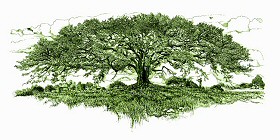| |
|
|
The Basics of Tree Pruning
MERISTEM
TIPS :: VASCULAR
SYSTEM :: TRANSPIRATION
:: THE 1/3 RULE
THE BRANCH COLLAR
:: TARGET PRUNING
:: CONCLUSION
:: GLOSSARY |
The
target pruning method is an an overall pattern of care that focuses
on the needs of the tree, and directs the pruning by removing material
that is no longer contributing to the tree’s health or beauty.
Dead wood such as shade out die back, broken wood, damaged wood,
rubbing and crossing branches, narrow crotching structures, and
root crown shoots are typical target cuts.
The largest cuts are made first. As the dead wood is removed, and
the tree’s most obvious problems are corrected, the tree is
reduced to a more sustainable form, and it is easier to assess its
needs. This is a continuing process throughout the pruning. As material
is removed, the tree is observed, and more corrections are identified.
|
SHADE
OUT DIE-BACK
| When
light is no longer able to reach inside the tree because of
shade from the canopy, the tree spontaneously begins to withdraw
energy from interior shoots. This is not a sign of disease,
rather it indicates the tree is redirecting its energy out to
the tips. This dead wood can be removed to reduce the interior
burden in the tree, open the interior, and allow the tree to
focus its energy on more productive structures. |
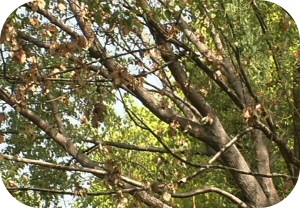
|
|
DAMAGED
LIVE WOOD
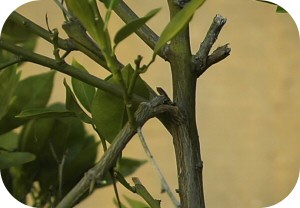
|
After
we remove the dead wood from the tree, the next step is to
eliminate living wood that is diseased or damaged, and that
ultimately will not contribute to the tree’s health
or beauty.
|
|
ROOT
CROWN SHOOTS
Root
crown shoots emerge around the base of the tree, and are not
a desirable part of the tree’s structure. They draw
the tree’s energy into unproductive forms, and if left
unpruned, may grow to compete with the lead of the tree, causing
it to grow in a confused structure. They should be removed
in order to refocus the tree’s energy and keep the tree
in a natural form. The shoots should be cut above soil level,
in draining cuts to pre-vent decomposition and decay.
|
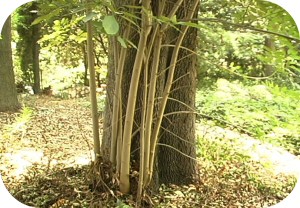
|
|
NARROW
CROTCHING STRUCTURES
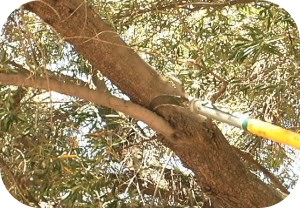
|
This
limb is exhibiting what is known as a narrow crotching structure.
The branch has a very tight angle of emergence from the main
leading trunk. This tight angle creates a focus of stress,
a weak structural form in the tree’s scaffold, and the
branch is vulnerable to wind damage.
|
|
This
is an example of a strong angle of emergence. There is a large
radius which distributes the force of stress and makes for
a healthy attachment.
|
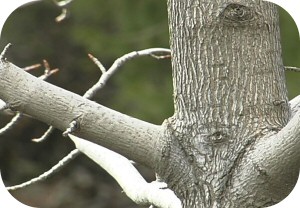
|
|
RUBBING/CROSSING
BRANCHES
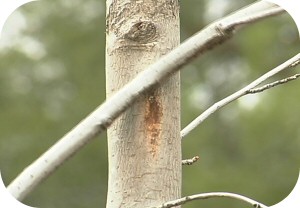
|
This
is an example of a rubbing and crossing branch. Bark damage
is beginning to develop, and this could represent a long term
problem for the tree.
|
|
PARALLEL
LEADS
Many
times a tree will send out several competing leaders into the same
area. It is sometimes necessary to choose which is the best placed,
which is the strongest, which has the nicest morphology and keep
that one, and remove the one that’s going to interfere.
This
is an example case of a narrow crotching trunk, a double lead,
and a root crown shoot, all of which are undesirable. The
way to send this tree into the future, to give it the best
form and character is to train to our single leading trunk.
|
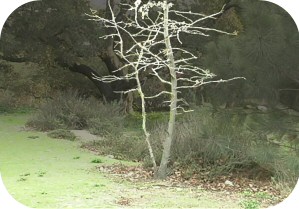
|
|
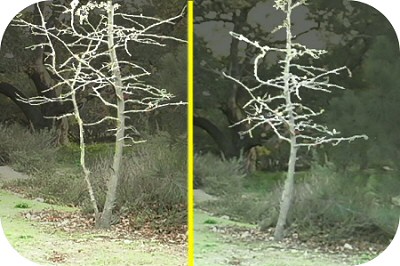 We
have taken a tree that was growing in a double lead, which was diffusing
the tree’s energy, and detracting from its natural beauty. We
have taken a tree that was growing in a double lead, which was diffusing
the tree’s energy, and detracting from its natural beauty.
By removing the undesirable shoot, we’ve avoided a serious
defect in the future, and directed the tree’s energy into
a more graceful structure.
Once
the important, targeted cuts, are made, the tree’s most serious
issues are addressed and it can be re-examined with an eye to finer
adjustments. We can then let the tree run on its own genetic map,
and it may not require pruning for another 5 years or more. |
<<
BACK • NEXT
>>
|
|
